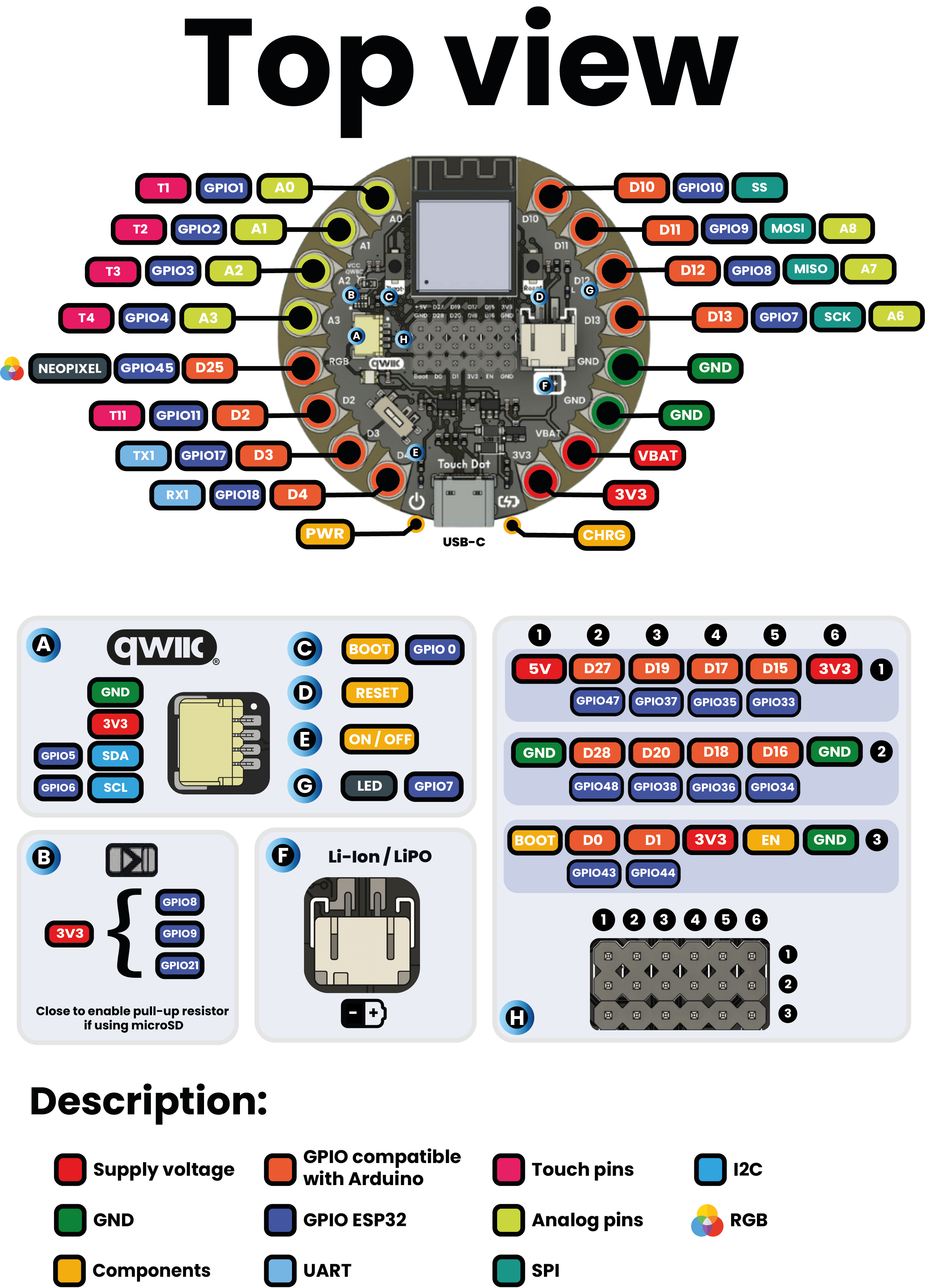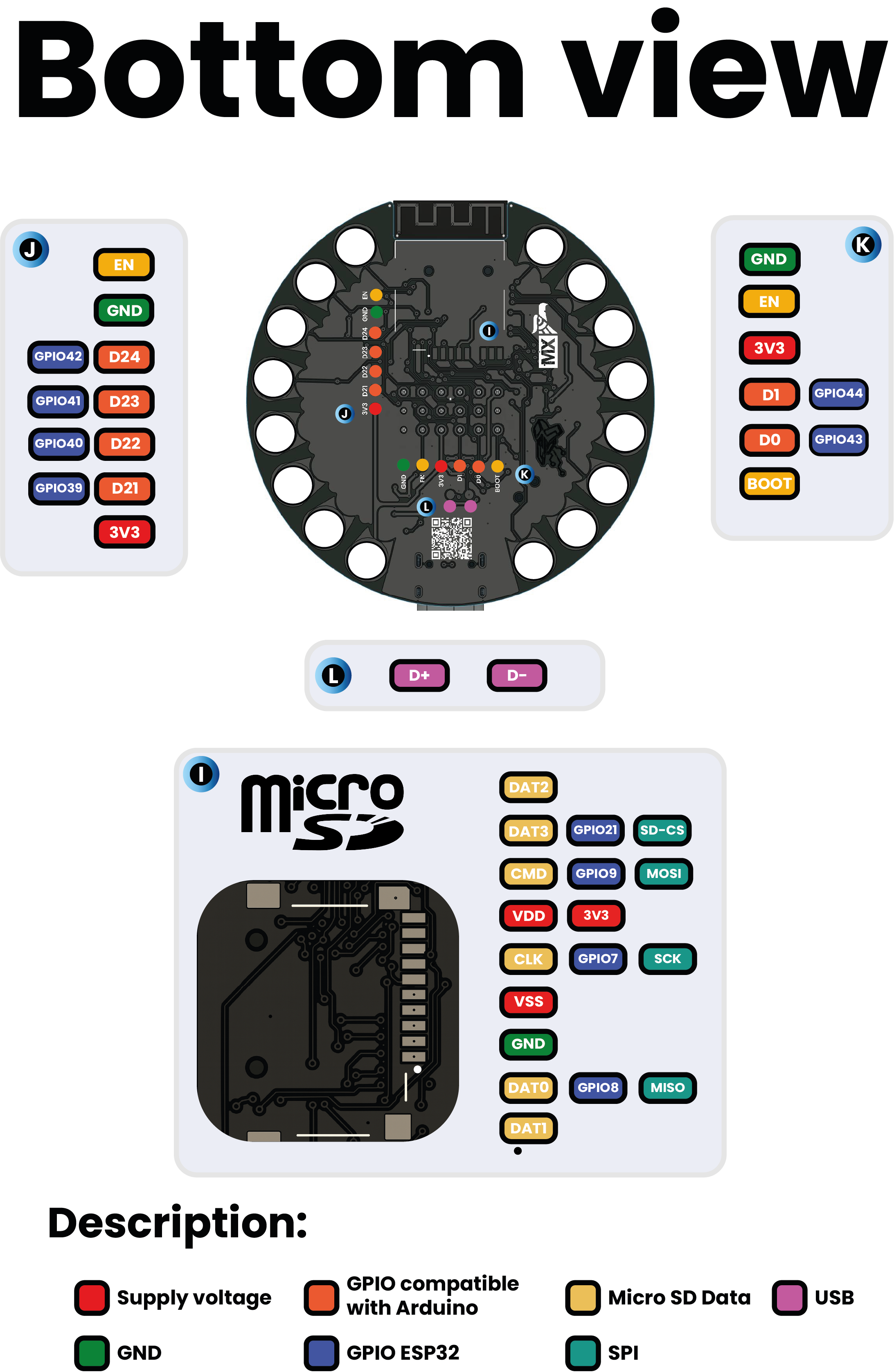Touchdot S3
Leveraging the ESP32-S3 chip, the Touchdot S3 is a versatile development board crafted for creative wearables, IoT implementations, and smart devices. Inspired by the Lilypad aesthetic but delivering modern functionality, it marries a compact form factor with robust connectivity and power management features for seamless prototyping.
Additional Resources
| Resource | Link |
|---|---|
| Wiki-UNIT Electronics | Wiki-Uelectronics |
| GitHub Repository | GitHub Repository |
| Product Brief | Product Brief |
| Schematic | Schematic |
| Documentation | Documentation |
Microcontroller: ESP32-S3 Mini
- Energy Efficient: Optimized for low power consumption.
- 3.3 V Power Rail: Compatible with wearable sensors and peripherals like QWIIC modules.
- Wi-Fi and Bluetooth 5: Supports 2.4 GHz Wi-Fi (802.11 b/g/n) with 40 MHz of bandwidth and Bluetooth Low Energy subsystem
- CPU: Xtensa® dual-core 32-bit LX7 microprocessor
- Memory: 384 KB Rom, 512 KB SRAM, and 16 KB SRAM in RTC
Power Supply & Battery Management
- USB-C Charging & Communication: Ensures reliable power delivery and straightforward programming.
- Integrated LiPo Battery Management: Streamlines power safety and efficiency without extra circuitry.
- Distributed Power Pads: Magnetic connectors deliver GND and 3.3 V for simple, reliable wiring to sensors and actuators.
Pinout
Top View
Bottom View
GPIOs
- Sewable Pads: 16 sewable pads in total: 11 programmable multiplexed GPIOs, 1 for Neopixel output data, and 4 for power supply.
- Pin Headers: 18 pin headers complement the sewable pads; use these to access more GPIOs and functions such as boot or enable.
Key Features
| Feature | Description |
|---|---|
| Wi-Fi & Bluetooth LE | Dual wireless connectivity for seamless IoT and mobile interactions. |
| Built-in LiPo Charging | Reliable battery charging integrated into the board design. |
| Power & Reset Controls | Direct access to board power management with dedicated buttons for power and reset. |
| Sewable Pads & Magnetic Connectors | Ideal for wearable projects and rapid prototyping with flexible module integration. |
| Multiple Solder Points for GND & 3.3 V | Facilitates easy wiring to external sensors or actuators without complex setup. |
| Standard QWIIC Connector | Supports quick connection of I²C peripherals such as sensors, displays, and expansion modules. |
| Power On Switch | Easily turn on the device with an SPST switch. |
| Built-In LED | LED connected to D13. |
| RGB LED | Neopixel 2020 LED, data input connected to D25 and data output to a sewable pad. |
| Micro SD Slot | Manage data on Micro SD cards with the SPI protocol. |
Example Code
#include <Wire.h>
#include <Adafruit_NeoPixel.h>
#include <Adafruit_GFX.h>
#include <Adafruit_SSD1306.h>
#define SCREEN_WIDTH 128
#define SCREEN_HEIGHT 64
#define OLED_RESET -1
#define SDA_PIN 5
#define SCL_PIN 6
#define PIN_LED 45
#define NUM_LEDS 1
#define BUTTON_PIN 0
TwoWire i2c_oled(1);
Adafruit_SSD1306 display(SCREEN_WIDTH, SCREEN_HEIGHT, &i2c_oled, OLED_RESET);
Adafruit_NeoPixel strip(NUM_LEDS, PIN_LED, NEO_GRB + NEO_KHZ800);
uint32_t colors[] = {
strip.Color(128, 0, 0),
strip.Color(0, 128, 0),
strip.Color(0, 0, 128),
strip.Color(128, 128, 0),
strip.Color(0, 128, 128),
strip.Color(128, 0, 128),
strip.Color(128, 128, 128),
strip.Color(64, 64, 0),
strip.Color(0, 64, 64),
strip.Color(64, 0, 64),
strip.Color(0, 0, 0)
};
const char* colorNames[] = {
"Red", "Green", "Blue", "Yellow", "Cyan", "Magenta", "Gray", "Ochre", "Turquoise", "Purple", "Off"
};
int colorIndex = 0;
bool lastButtonState = HIGH;
unsigned long lastPressTime = 0;
bool autoMode = false;
bool colorLocked = false;
void setup() {
Serial.begin(115200);
pinMode(BUTTON_PIN, INPUT_PULLUP);
strip.begin();
strip.show();
i2c_oled.begin(SDA_PIN, SCL_PIN);
display.begin(SSD1306_SWITCHCAPVCC, 0x3C);
display.clearDisplay();
display.setTextSize(1);
display.setTextColor(SSD1306_WHITE);
display.setCursor((SCREEN_WIDTH - 72) / 2, (SCREEN_HEIGHT - 8) / 2);
display.println(" NeoDemo");
display.display();
for (int i = 0; i < 128; i += 8) {
strip.setPixelColor(0, strip.Color(i, 0, 128 - i));
strip.show();
delay(20);
}
delay(1500);
display.clearDisplay();
lastPressTime = millis();
}
void loop() {
bool currentButton = digitalRead(BUTTON_PIN);
if (!autoMode && lastButtonState == HIGH && currentButton == LOW) {
lastPressTime = millis();
colorIndex = (colorIndex + 1) % (sizeof(colors) / sizeof(colors[0]));
updateDisplay();
strip.setPixelColor(0, colors[colorIndex]);
strip.show();
colorLocked = true;
}
if (!autoMode && !colorLocked && millis() - lastPressTime > 3000) {
autoMode = true;
display.clearDisplay();
display.setCursor(10, 20);
display.setTextSize(1);
display.println("AUTO mode activated");
display.display();
}
if (autoMode) {
uint8_t r = random(0, 129);
uint8_t g = random(0, 129);
uint8_t b = random(0, 129);
strip.setPixelColor(0, strip.Color(r, g, b));
strip.show();
delay(100);
}
lastButtonState = currentButton;
delay(50);
}
void updateDisplay() {
display.clearDisplay();
display.setTextSize(1);
display.setCursor(0, 0);
display.println("Selected color:");
display.setTextSize(2);
display.setCursor(5, 25);
display.println(colorNames[colorIndex]);
display.display();
}


